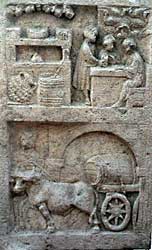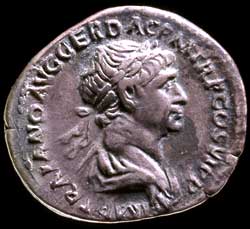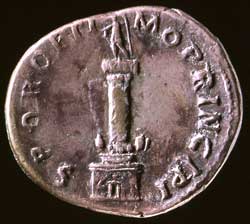
Click on the image for a larger version.
|
Image
details:
Scene on a 2nd / 3rd century AD funerary
monument from Trier.
An ox pulls a cart bearing a large wine barrel. In the panel
above, a barrel and an olive oil amphora wrapped in rope,
in front of a counter.
Image ownership:
VRoma (Photo Barbara McManus), Landesmuseum, Trier |
Many tablets contain references to the supply of food and clothing,
as well as raw materials for building, manufacture and repair. Some
of Vindolanda's provisions came from the fort's immediate surroundings,
but for much of its supplies, especially grain, Vindolanda probably
depended on lower lying parts of north-east England better suited
to cereal growing. Staples including cereals and ham or bacon were
also transported from southern England or neighbouring provinces.
Longer distance supply routes brought the products of the Mediterranean,
wine, olive oil and fish sauce, as well as other exotic items such
as pepper, to Britain's northern frontiers. On these routes other
goods rode 'piggy-back', for example the distinctive glossy red
tableware known as samian or terra sigillata made in Gaul.
The garrison's requirements were therefore procured from local
and long-distance sources. The tablets shed some light on the highly
complex mechanisms by which supplies were obtained and redistributed.
There are occasional references to the large scale movement of supplies.
In the most striking instance a certain Octavius writes expressing
concern over losing a deposit he has paid on a large amount of grain,
5000 modii (343). This would
have been enough to supply the whole garrison with bread for several
weeks. Octavius and his correspondent, Candidus, may be civilians
holding a contract for supplying the army.
Most documents however record the movement of modest amounts of
commodities within the fort itself. 180
for example records the issue of grain over several days to various
individuals, in quantities of a few modii, perhaps for their
own consumption, perhaps collected on behalf of a group. As well
as food such accounts (255)
mention clothing, also probably transported over a long distance,
perhaps from Gaul: one records the receipt and redistribution of
capes, tunics and other clothing, perhaps within a contubernium.
Often foodstuffs, clothing and other commodities are found in the
same accounts (184,
186,
192).
On the smallest scale are the record of individual gifts (299)
and an account for perhaps a single meal (203).
Some documents apparently inventorise household stocks (194,
196). As well as ensuring efficient
supply, record keeping was perhaps directed against the risks posed
by petty theft or graft, especially where large bodies of men and
material were on the move. The regular marking of property by names
of individuals or units suggests that a close watch had to be kept
over property.
While some supplies reached the frontier by sea, much depended
on the road network. Bulk commodities would have been carried in
slow moving ox-drawn wagons: one tablet refers to not risking the
beast of burden while the roads were bad (343).
Smaller, faster horse-drawn vehicles, of which the raeda
(185)
was one type, would have carried people .
Some supplies were obtained through the market . A letter (302),
possibly addressed to the slave of the prefect, Verecundus, refers
to the purchase of 20 chickens and sends instructions to buy 'good-looking
apples' and eggs in large quantities 'if they are on sale there
at a fair price'. The large number of coins found at Vindolanda
suggests that money circulated as coinage, not just on paper.

Click on the image for a larger version.
|
Image
details:
A silver denarius of the emperor Trajan.
The obverse bears his bust, the reverse Trajan's column. AD
112-14.
Image ownership:
Copyright Ashmolean Museum, University of Oxford |

Click on the image for a larger version.
|
Image
details:
A silver denarius of the emperor Trajan.
The obverse bears his bust, the reverse Trajan's column. AD
112-14.
Image ownership:
Copyright Ashmolean Museum, University of Oxford |
Price information is crucial to economic and social historians,
but we have very little from the Roman world, and most of this from
Egypt. The records of sums of money and prices for goods from Vindolanda
give us information from the opposite corner of the empire for the
first time, although frustratingly the price, commodity and amount
are rarely all documented together. Two prices give us an idea of
the range of costs. An unknown amount of pepper (185)
cost two denarii (or half a legionary's weekly wage), while 100
pints of beer (186)
cost half a denarius (just over half a legionary's daily wage).
Tablet database link: Browse all tablets related to transport or supplies.
|